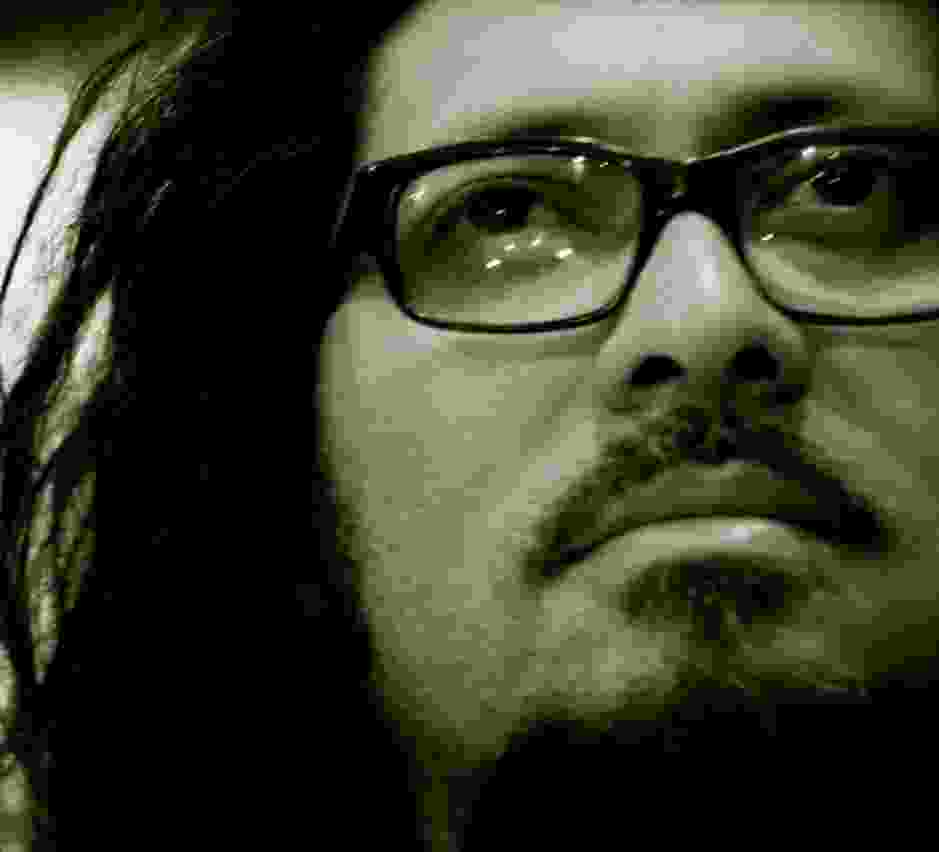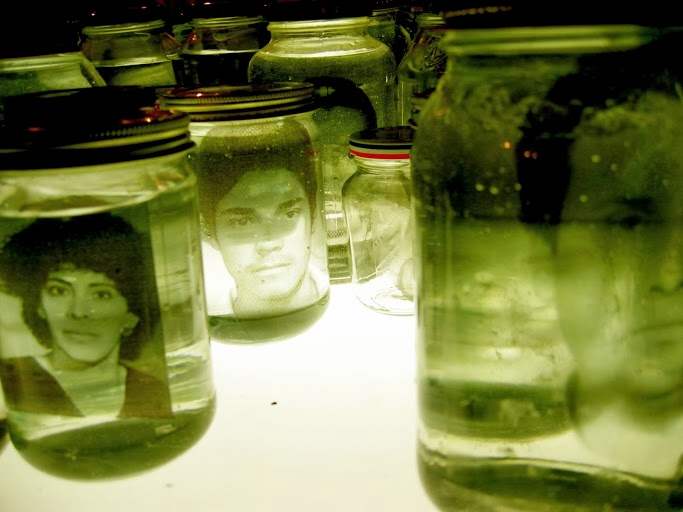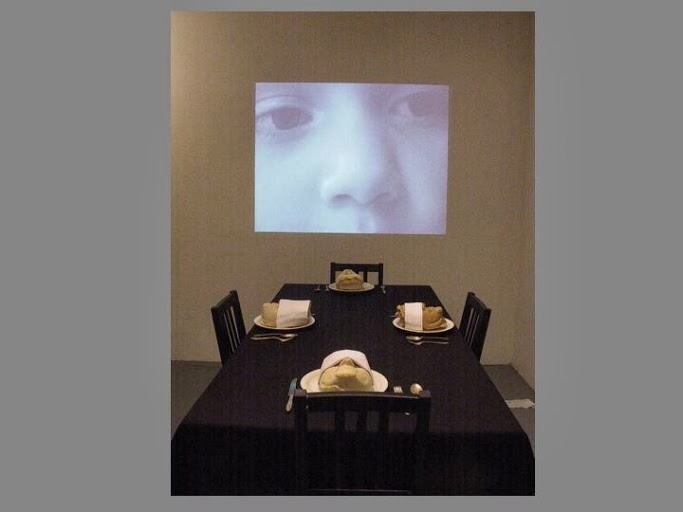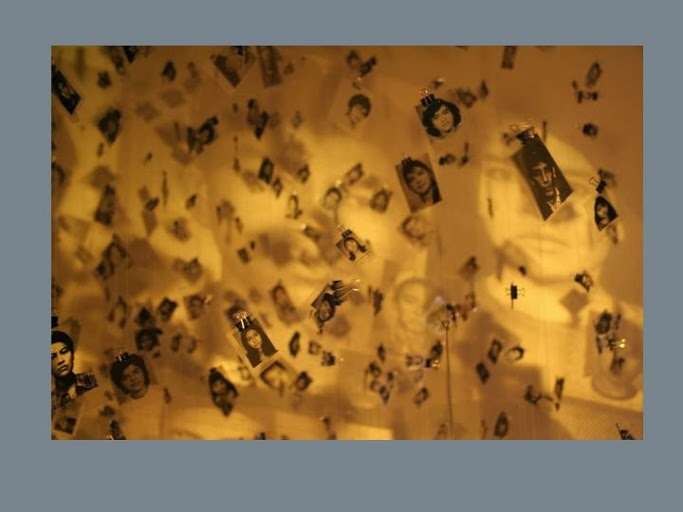the art and interview of
VICTOR CARTAGENA

by
ELENA MARIAKHINA
___________________________________________
Salvadoran
born artist Victor
Cartagena has been living and making art in San Francisco,
CA since the late 1980s. His installations, well known in
America as well as internationally, concern themselves with
issues such as immigration, bureaucracy and violence. Victor's
award-winning art is both shocking and truthful, and has been
the subject of several television reports and commentaries.
ELENA
MARIAKHINA: You came to America as a refugee from El Salvador.
How does your Salvadoran heritage and subsequent immigration
influence your art?
VICTOR
CARTAGENA: I came to America in the late 80s by necessity.
The Salvadoran Civil War meant that young people had a choice
of either joining the guerrillas or the army. I am against
 violence
so I left El Salvador with thousands of others. We thought
we would stay away for no longer than two years but the situation
in El Salvador hasn't changed. So now, 27 years later, I'm
still in America.
violence
so I left El Salvador with thousands of others. We thought
we would stay away for no longer than two years but the situation
in El Salvador hasn't changed. So now, 27 years later, I'm
still in America.
What
I, and my whole generation, witnessed in El Salvador had a
profound influence on my way of thinking. The violence and
injustice marked my life, and it will take time, perhaps a
lifetime, to process. Now, whenever I see examples of injustice
anywhere in the world, I'm reminded of El Salvador and I can't
help but respond with my art.
EM:
How did your passion for art develop?
VICTOR
CARTAGENA: Honestly, I never dreamt I'd be an artist. I thought
I would be a musician, and I used to play in a band, but I've
always been surrounded by art. My father was a wonderful draftsman.
He worked in a medical school doing anatomical drawings. His
images sparked my first interest in art. My father died when
I was five but I still have powerful memories of him: one
of those memories is of his teaching me to draw. My relatives
ran a framing shop, so I was exposed to many art images. When
I was sixteen the events in my country forced young people
to learn practical skills to survive. After school young people
were learning to be carpenters or electricians but that didn't
appeal to me so I found a job in a small printing shop. There,
during lunch time, I used to draw but hid my drawings until
someone saw my work and encouraged me to continue my art.
I then moved to the U.S. and needed to survive and I found
a job in a framing shop which was another contact with art.
When I wasn't working I spent my time writing letters to my
family and drawing since I didn't have friends or family here.
Two or three years after that I began to do some painting
and found it was a great way to express myself.

EM:
Which artists influenced your early work?
VICTOR
CARTAGENA: I was very influenced by Mexican muralists. Everyone
in California, at that time, was talking about the Mexican
art movement: artists like Diego Rivera and Frieda Kahlo.
While I worked at the  framing
shop many people brought Rivera and Kahlo posters to be framed.
Their work influenced me because it was so connected to my
own country and culture.
framing
shop many people brought Rivera and Kahlo posters to be framed.
Their work influenced me because it was so connected to my
own country and culture.
EM:
What was the fortuitous event or, as they say, the lucky break
that launched your art career?
VICTOR
CARTAGENA: In 1992, around Christmas, I was painting canvases
on a California street when a man stopped and proposed, "I
can give you a show." I couldn't believe it and said,
"are you kidding me, I'm just doing this for my own entertainment."
But he asked me how many pieces I had and I told him I only
had about five works. He connected me with people from an
exhibition. I haven't stopped working on my art since! Life
is so amazing for me because I have the opportunity to express
myself, to say what I want to say and how I want to say it.
EM:
What led you to installation art?
VICTOR
CARTAGENA: A friend who works as a theatre actor and I joked
about doing the set for his next play. A week later he called
me to say that the theatre directors wanted a set from me.
I read the play and created a very unconventional set. Amazingly,
critics were talking about it and I began to receive invitations
from galleries and museums, such as The Oakland Museum of
California, to create other installations. It's a good fit
for me --combining different elements -- as a great way to
express my ideas.
EM:
How and why did you start working on your, now famous installation,
Culture of Violence?

VICTOR
CARTAGENA: The idea for the piece came about because the newspapers
were full of stories about gun violence. Students can kill
students, teachers and even their parents for seemingly ridiculous
and petty reasons. I collected all these newspaper articles
and couldn't believe that people still wanted to protect gun
ownership. I don't understand that parents are still buying
toy guns for their children. When I was a child, I remember
fighting with another boy, with our hands, and we were both
crying and upset but when the fight was over we went back
to playing. We didn't think about killing each other.
EM:
Are you saying that government is responsible for increased
violence?
 VICTOR
CARTAGENA: The weapons industry is responsible for that, and
most politicians work for their own interests. Could you imagine
a philosopher as a prime-minister or a poet as a vice-president
(smiling)?
VICTOR
CARTAGENA: The weapons industry is responsible for that, and
most politicians work for their own interests. Could you imagine
a philosopher as a prime-minister or a poet as a vice-president
(smiling)?
EM: Why does your installation depict politicians as having
red noses?
VICTOR
CARTAGENA: That's an allusion to Pinocchio and lying. The
more you lie the longer and redder your nose grows. This is
my scream, "I don't believe you, and I know that you're
lying to me."
EM:
Your installation, Invisible Nation, is about immigration.
How did you develop your idea of putting thousands of tiny
photos into jars and into tea bags and pills?
VICTOR
CARTAGENA: I accompanied a student from SF State University
on a project in El Salvador. I hadn't been back there since
moving to the US. I visited an old photo studio that had gone
out of business due to digital technology, but had kept all
the negative files. I collected thousands of photos of people
who had, like me, left the country. When the Oakland museum
asked me to present an installation I decided to use the photos
to talk about immigration. I put each photo into a tea bag,
pill or jar to symbolize the place of immigrants in our culture.
Wealthy people use immigrants to feed their need for gardeners,
babysitters and other menial labour. Immigrants are considered
lower class people. They pay taxes but often can't get health
care. Immigrants are a vital part of the economy but are the
first to suffer in an economic downturn. I'm using my art
to show that immigrants should be seen as valuable human beings,
not a commodity.
 EM:
So you have a political agenda?
EM:
So you have a political agenda?
VICTOR
CARTAGENA: Everything is political, everything. I respond
to what is going on around me. I like to think and analyze.
I care about what is going on in my home town, in Pakistan,
Iraq and Palestine etc. That's not about being political --
that's just being human.
EM:
What would you compare art with?
VICTOR
CARTAGENA: With music. Good music can touch people's hearts.
Like music, art can make you feel different. It may remind
you of what's important, and if people feel it, they may change
the world around them.
EM:
Do you believe that art can change the world?
VICTOR
CARTAGENA: Change the world? . . . I don't know, it's hard
to say that art really changes the world. Pablo Picasso painted
the large and beautiful "Guernica" as an antiwar
statement, but wars continue. People stop one war and start
another and artists keep trying to change something. At least
we make people think. We don't give up. I believe that art
educates. If children are exposed to art, poetry, music and
theatre we might create a society with a different mentality.
There is nothing more important than art and education. Kids
exposed and influenced by art will stay away from violence.
EM:
Thank you.